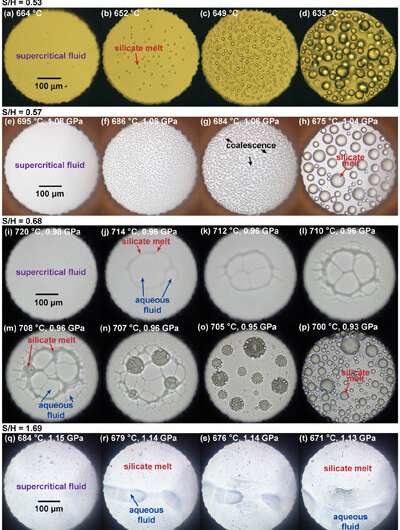Mechanism and evolution process of supercritical fluid

Fluids are like the "blood" inside the solid Earth, playing an important role in the transportation of matter and energy. Due to the compositional difference, rocks that composed mainly of silicate and common fluids have a typically low level of miscibility.
Under the high temperature and pressure conditions deep in the Earth, silicate and fluids can be completely mixed, forging a supercritical geological fluid with the composition "thicker" than magmatic melts and "thinner" than aqueous liquids. However, much remains to be done to reveal the evolution process of supercritical fluid because of the difficulties in experimenting.
In a study published in Geochemical Perspectives Letters, a research team led by Prof. Ni Huaiwei from University of Science and Technology of China (USTC) of the Chinese Academy of Sciences found mechanism and the unmixing process of supercritical fluid.
Prof. Ni's team observed the phase separation process of silicate-water system with the decreasing of temperature and pressure.
The experiment showed that besides regular nucleation-growth mechanism, supercritical fluid could be separated through spinodal decomposition. Due to the difference of dynamic property between silicate and water, the silicate composition with a low relaxation could support the elastic stress and form a network of silicate melts in the fluids. But when the temperature further dropped, the interfacial tension increasingly enlarged, leading to the disintegration of melt networks.
This kind of melt network can facilitate the simultaneously capture of silicate melts and aqueous fluids with different proportions when mineral crystallizations crystalize. Meanwhile, the spinodal decomposition of the integral decomposition mechanism will significantly contribute to the efficiency of the melt-fluid phase separation, which may have important implications for the formation of magmatic hydrothermal deposits.
This study reported for the first time the spinodal decomposition of supercritical fluid and the formation of magmatic network.
More information: Q.X. Wang et al, Spinodal decomposition of supercritical fluid forms melt network in a silicate-H2O system, Geochemical Perspectives Letters (2021). DOI: 10.7185/geochemlet.2119
Provided by Chinese Academy of Sciences




















